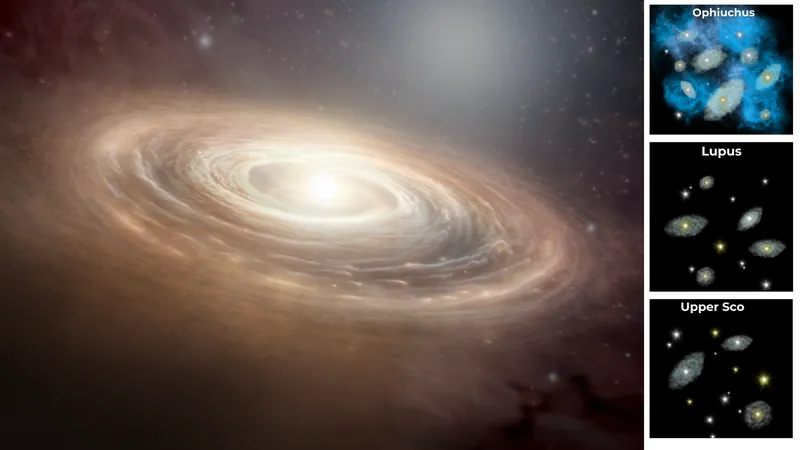
Unveiling the Secrets of Baby Planet Growth: Astonishing Findings from 30 Stellar Nurseries!
2025-06-17
Author: Li
Infant planets are voracious beings, rapidly consuming the remnants of the gas and dust clouds that birthed them. Within just a few million years, the gas in these protoplanetary disks vanishes, a phenomenon that has captivated astronomers. Fortunately, a groundbreaking study has now illuminated this process of planetary evolution like never before.
A Revolutionary Study in Planetary Formation
An international team of astronomers conducted this innovative research using the Atacama Large Millimeter/submillimeter Array (ALMA) as part of the ambitious ALMA Survey of Gas Evolution of PROtoplanetary Disks (AGE-PRO). By investigating 30 protoplanetary disks surrounding sun-like stars, they discovered that the gas and dust within these disks evolve at distinct rates. The remaining gas dictates the types of planets that will ultimately form, offering critical insights into the formation of planetary systems, including our solar system.
The significance of the AGE-PRO study is remarkable, having spurred 12 additional research papers from various teams, underscoring the transformative nature of these findings.
The Cosmic Journey of Planet Formation
Planetary formation begins deep within interstellar molecular clouds, where clumps of dense, cool gas collapse under their own gravity to form stars. These early stars, known as protostars, continue to gather matter from their gas envelops.
What remains is a main sequence star shrouded by a swirling protoplanetary disk of gas and dust. As materials within this disk collide and adhere to one another, they gradually assemble into planetesimals, which eventually evolve into full-fledged planets. It’s estimated that these disks can cradle infant stars for several million years, setting the stage for the formation of giant planets.
Crucial Factors in Planet Evolution
The initial size, mass, and angular momentum of protoplanetary disks critically influence the types of planets that emerge. Furthermore, the lifespan of the gas affects how long fragments can continue to gather material, essentially determining their growth into larger planetary bodies. Fascinatingly, this also influences whether planets migrate within their disks, adjusting their positions relative to their parent stars.
Prior studies concentrated mainly on the evolution of dust content in these disks, but the recent research sheds light on how gas content changes over time.
AGE-PRO: A Milestone in Astronomy
The AGE-PRO study delivers the first comprehensive measurements of gas disk masses and sizes throughout the lifespan of planet-forming disks. By deploying ALMA, researchers scrutinized 30 disks ranging in age from 1 million to over 5 million years, located in star-forming regions across the constellations Ophiuchus, Lupus, and Upper Scorpius.
Using advanced technologies, the team tracked various chemical markers revealing gas and dust mass changes during critical stages of disk evolution, marking a significant leap in our understanding of these cosmic entities.
Unraveling the Mysteries of Planetary Birth
The study provides intriguing insights into the timelines for gas giant planets like Jupiter and Saturn compared to terrestrial worlds such as Earth and Mars.
Findings reveal that the average mass of gas disks drops from several Jupiter masses in the earliest stages to less than one Jupiter mass within the first few million years. This shift indicates that while there is ample material available for giant planets in the early stages, this resource diminishes significantly as time passes.
Surprisingly, disks that persist for 2 to 3 million years maintain a gas mass comparable to younger disks—a revelation that challenges prior estimates of planetary atmospheric development.
A Surprising Twist in Disk Dynamics
One of the most intriguing discoveries was the differing rates at which gas and dust are consumed as protoplanetary disks age. The this finding suggests a complex interplay of materials, particularly as gas is consumed differently compared to dust.
This crucial research offers an enriched perspective on how planetary systems evolve, setting the stage for deeper investigations into the mysteries of our universe. Stay tuned, as the AGE-PRO findings continue to illuminate the captivating journey from star birth to planetary formation!

 Brasil (PT)
Brasil (PT)
 Canada (EN)
Canada (EN)
 Chile (ES)
Chile (ES)
 Česko (CS)
Česko (CS)
 대한민국 (KO)
대한민국 (KO)
 España (ES)
España (ES)
 France (FR)
France (FR)
 Hong Kong (EN)
Hong Kong (EN)
 Italia (IT)
Italia (IT)
 日本 (JA)
日本 (JA)
 Magyarország (HU)
Magyarország (HU)
 Norge (NO)
Norge (NO)
 Polska (PL)
Polska (PL)
 Schweiz (DE)
Schweiz (DE)
 Singapore (EN)
Singapore (EN)
 Sverige (SV)
Sverige (SV)
 Suomi (FI)
Suomi (FI)
 Türkiye (TR)
Türkiye (TR)
 الإمارات العربية المتحدة (AR)
الإمارات العربية المتحدة (AR)